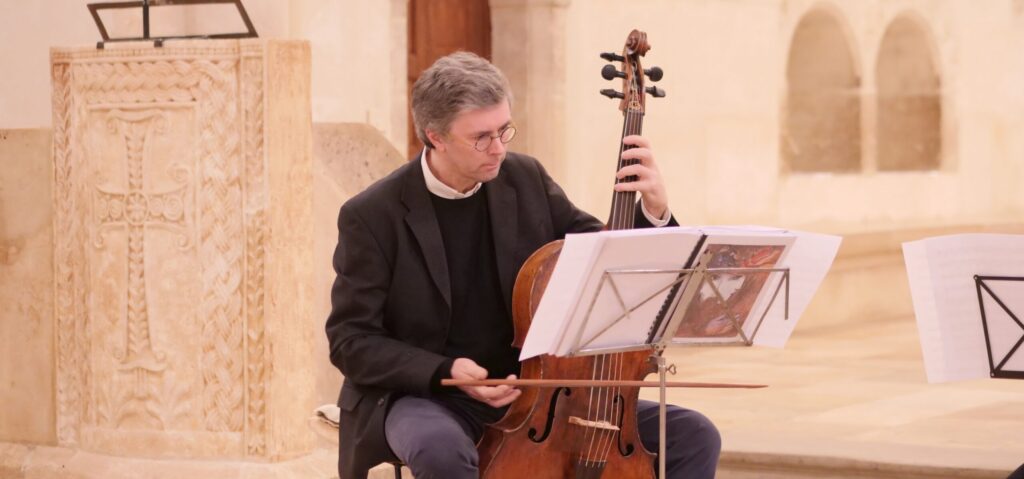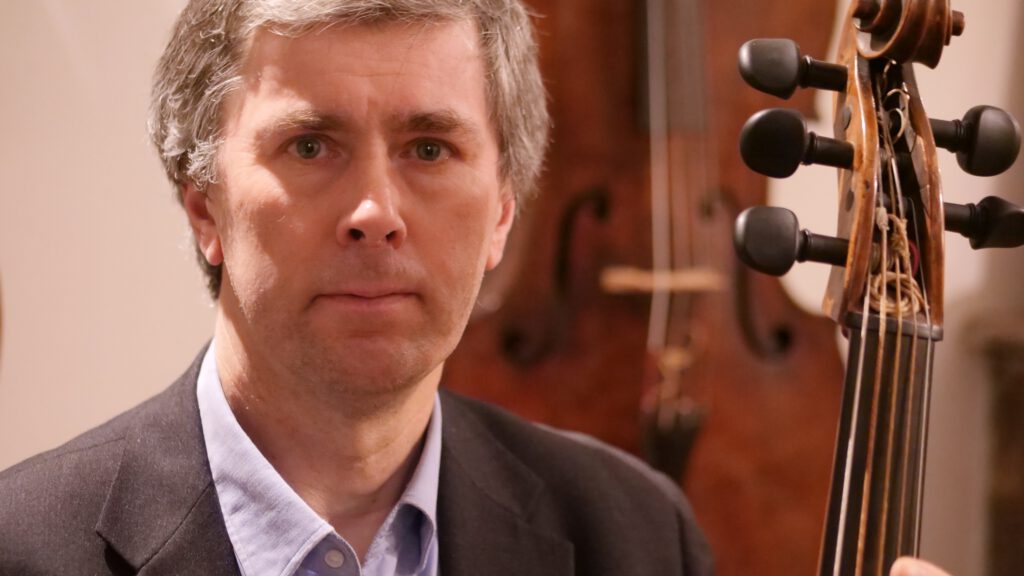Hervé Douchy
violoncello
After completing his training at the Brussels Conservatoire, Hervé Douchy secured his first position with the RTBF Symphony Orchestra. It was a pivotal encounter with Sigiswald Kuijken that inspired him to embrace the historical cello, a path he pursued under the guidance of Hidemi Susuki.
He embarked on a career as a freelance concert musician, collaborating with various Belgian and international ensembles, including La Petite Bande, La Cetra d'Orféo, Il Gardelino, La Pastorella, Le Concert Royal, Akademia, Le Poème harmonique, and Les Sonadori (a renaissance violin consort). Notably, his almost two-decade-long association with Les Agrémens involved extensive performances, tours, and recordings. His close partnership with Guy Van Waas, especially within Les Agrémens, paved the way for his involvement in higher education. Initially at the Mons Conservatoire, where he teaches chamber music, and later in Brussels, instructing baroque cello.
His encounter with Marc Vanscheeuwijck (University of Oregon) proved to be pivotal in shaping his cello class, infusing it with a blend of research and practical application. This integration is evident in the utilization of various instruments (violin basses, violoncelli) played in different positions (sitting or standing, in procession, with the bow held down) and featuring numerous 4- or 5-string chords. He performs on historical instruments, as well as those crafted by the Brussels luthier Pierre Van Engeland, with whom he has collaborated closely for over 25 years. A similar collaboration extends to bow maker Jérôme Gastaldo. Since 2011, he has been regularly presenting Bach suites in concerts. In 2018, he initiated the 'Bach and transcendence' symposium organized by the University of Louvain-La-Neuve.
Hervé Douchy's professional journey to date has undeniably been influenced by encounters. His musical practice and teaching choices are continually shaped through interactions with seasoned musicians, colleagues, and students, fostering an ongoing process of reflection and evolution.
He aligns with Lydia Goehr's perspective, emphasizing the importance of "keeping our eyes open to the intrinsically critical and revisable nature of our concepts.' Moreover, this approach aids in overcoming the deep-seated desire to harbor the most perilous belief of all—that we have always had practice absolutely right" (Performance Practice: Issues and Approaches by Christina Kyprianides, 2009).
Personal approach
As part of an ongoing research project, the CrB's baroque cello class is formulating a method structured around three historical practices of the seventeenth and eighteenth centuries adapted to the cello: Continuous Bass, Ornamentation, and Rhetoric.
Today, the role of a cellist trained on historical instruments primarily involves playing the basso continuo in seventeenth- and eighteenth-century scores, much like other instruments such as the harpsichord, organ, lute, theorbo, or viola da gamba. This entails doubling the bass line, while instruments like the harpsichord or lute provide harmonic realizations of this bass. Recent research, especially into the Neapolitan conservatories of the early eighteenth century, has revealed that the cello can also 'realize' this multi-voiced basso continuo. This newfound insight expands the cellist's role beyond the traditional one, now including the production of harmonic realizations that guide the voices and suggest melodic lines.
These melodic lines, derived from realizations, demand ornamentation that embraces the principles of rhetoric and adjusts to the 'good taste' of the specific place and time. The practice of basso continuo on the cello, encompassing harmonic realization, improvisation, and contextualized rhetoric, waned in the mid-nineteenth century. This decline coincided with the evolution of music, which shifted the role of the cello to performing a single, fully written melodic line.
Since the early 2000s, numerous researchers have published scientific articles on the topic of basso continuo on the cello. However, as of now, none has developed a tool to effectively transfer these techniques to the practices of contemporary professional musicians. To address this gap, we have established a practical research team dedicated to designing and producing a tool that will facilitate a return to these historical practices. The creation of such specialized components demands expertise in both research and instrumental practice.
Hence, we assigned the production of the first two components to two outstanding former students, Valentin Bajou and Pierre Beaubatie, both of whom now serve as instructors in the CrB's baroque cello class. The third component was entrusted to Marc Vanscheeuwijck, an internationally acclaimed expert on the early cello and a teacher in the same class. Marc Vanscheeuwijck's global reputation as one of the foremost authorities on the early cello not only adds credibility to our research but also ensures its wider dissemination.
On April 29, 2023, the CrB organized the inaugural World Symposium on Continuous Bass for the cello. This symposium, attended by 80 baroque cellists, students, and teachers, featured the presentation of the first part of the method. Given the success of this event, the CrB has since launched a post-master's course in Continuous Bass for the cello.
A new symposium is scheduled for spring 2025. Starting from June 2025, the research findings will be released in both print and digital formats. The print edition, accompanied by a bilingual French-English PDF version, will be complemented by a practical application for iOS and Android. This innovative tool aims to provide users with a comprehensive resource for studying and practicing the techniques developed through the research.


